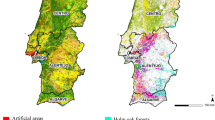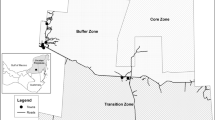Abstract
In this paper, forest protection, short- and long-rotation plantations, forestregeneration, agroforestry and other activities for carbon (C) sequestration wereevaluated. China may be divided into five sub-regions, of which three fallin the main forested areas of China, i.e., the northeast, the southeast andthe southwest regions. The forestry mitigation potential in these threeregions is the subject of this paper. The Comprehensive Mitigation AssessmentProcess (COMAP) model is used to calculatethe potential for carbon mitigation and the cost-effectiveness of eachmitigation option, assuming that 60 percent of the goals of long-termforestry plans of the Chinese government could be realized. The resultsshow that the total sequestered C by the mitigation scenario between2000 and 2030 for the three regions of China will be 2093 × 106 Mg C, ofwhich 281 × 106 Mg C will occur between 2008 and 2012. The total netbiomass sequestration (difference of mitigation and baseline scenarios) from2000 to 2030 and from 2008 to 2012 is 496 × 106 Mg C and 59 × 106 Mg Crespectively. The C sequestration potential could be higher if othertwo regions are included since the forest area of the two regions amount to26.5% of total forested area, in particular, the land area suitable forforestation in the northwest accounts for 45% of the total. The activitywith least investment cost per unit of C is forest regeneration, followedby long-rotation plantation and forest conservation. The mostinvestment-intensive activity is bioenergy. The total investment for all themitigation activities is US $12.7 billion. The above figures between2008–2012 provide an upper bound on the potential for early startprojects that might be eligible for the Clean Development Mechanism(CDM). The authors would like to note that the mitigation potential andcost-effectiveness of agroforestry and bioenergy projects need to be furtherstudied.
Similar content being viewed by others
References
Chinese Expert Group: 1999, ALGAS (Asian Least-cost Greenhouse Gas Abatement Strategy), People's Republic of China, Asian Development Bank, Manila, The Philippines, pp. 201.
Chinese Ministry of Forestry (CMOF): 1989, China Forest Resource Statistics 1983–1988, Beijing, CMOF (in Chinese).
CMOF: 1994, China Forest Resource Statistics 1989–1993, Beijing, CMOF (in Chinese).
CMOF: 2000, 'Long-term forestry planning', in J. Liu (ed.), National Ecological and Environmental Planning, Chinese Commercial United Press, Beijing, pp. 178–215.
Editorial Board of Annals of Agriculture in China: 1989, Annals of Agriculture in China 1988, Beijing, Agriculture Publishers (in Chinese).
Editorial Board of Annals of Agriculture in China: 1998, Annals of Agriculture in China 1997, Beijing, Agriculture Publishers (in Chinese).
Huang, W., Kanninen, M., Xu, Q. and Huang, B.: 1997, 'Agroforestry in China: Present State and Future Potential', Ambio 26(6), 394–398.
Research Team of China Climate Change Country Study: 1999, China Climate Change Country Study, Beijing, Tsinghua University Press, pp. 28–30.
Sathaye, J., Makundi, W. and Andrasko, K.: 1995, 'A Comprehensive Mitigation Assessment Process (COMAP) for the Evaluation of Forestry Mitigation Options', Biomass and Bioenergy 8(5), 345–356.
Xu, Deying: 1995, 'Potential of reducing atmospheric carbon by large-scale afforestation in China and related cost/benefit analysis', Biomass and Bioenergy 8(5), 337–344.
Xu, Deying: 1999, 'Forestry and land use change assessment', ALGAS (Asian Least-cost Greenhouse Gas Abatement Strategy) – People's Republic of China, Asian Development Bank, Chapter 4, Manila, The Philippines, pp. 73–97.
Zhang, P., Shao, G., Zhao, G., Master, D.C., Parker, G.R. Dunning, J.B. and Li, Q.: 2000, 'China's Forest Policy for the 21 Century', Science 288, 2135–2136
Author information
Authors and Affiliations
Rights and permissions
About this article
Cite this article
Xu, D., Zhang, XQ. & Shi, Z. Mitigation Potential for Carbon Sequestration Through Forestry Activities in Southern and Eastern China. Mitigation and Adaptation Strategies for Global Change 6, 213–232 (2001). https://doi.org/10.1023/A:1013383204154
Issue Date:
DOI: https://doi.org/10.1023/A:1013383204154




